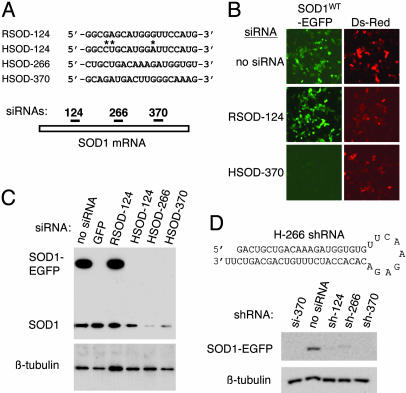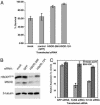
| PMC full text: | Published online 2004 Feb 23. doi: 10.1073/pnas.0308726100
|
Fig. 1.

Design and testing of siRNAs and shRNA constructs. (A Upper) Sequence of one rat and three human siRNAs; asterisks indicate mismatches between the rat and human SOD-124 siRNA sequences. For clarity, only the sense strand is shown. Numbers refer to the first nucleotide in the SOD1 target sequence, with the translation initiation codon designated as position 1. (Lower) Schematic representation of the relative positions, within the SOD1 coding region, of the three siRNA target sequences. (B) Fluorescence microscopy in live HeLa cells cotransfected with HSOD1-EGFP and siRNA directed against human (HSOD-370, Bottom) or rat (RSOD-124, Middle), along with pDsRed as a transfection control. (Left) HSOD1-EGFP fluorescence. (Right) DsRed-positive (i.e., transfected) cells in the same fields. (C) Immunoblot analysis of HeLa cells transfected with HSOD1-EGFP and the indicated siRNAs. A validated siRNA against GFP (22) was used as a positive control for silencing. (Upper) Upper band, SOD1-EGFP; lower band, endogenous SOD1. (Lower) β-Tubulin as a control for sample loading. (D Upper) Structure of the HSOD-266 RNA is shown as an example of a plasmid-encoded shRNA. (Lower) Immunoblot analysis of silencing in HeLa cells cotransfected with SOD1-EGFP and expression plasmids encoding the indicated shRNAs. HSOD-370 siRNA is used as a positive control for silencing.



